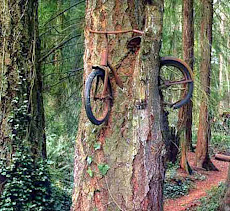We have to get serious about first reversing the damage that this current short-sighted, corporate robber baron that we call President of the United States has done. Then we need to heal the scars that our drive to profitability has left on this planet.
Mankind has always arrogantly placed itself above nature with the idea that everything is here for our amusement and pleasure. Resources are finite. Wildlife represents an integral link in the chain of life that helps supports every other link in that chain. We have all heard horror stories and speculations of what would happen if that chain were to fall apart. Respect is what is needed. Now, more than ever we need to respect what nature has to offer us and what we must do to give back and this requires the same thoughtful consideration we would like to bestow upon ourselves.
We don’t need vehicles that have the ability reach speeds above national speed limits that deplete copious amounts of fuel. We do not have to get from one part of the world to another so fast that excess fuel is burned just for the ability to do so.
We will not go hungry if we don’t have out-of-season foods on our dinner table and our health is not dependent on eating animals. Wearing animal parts is not a status symbol.
Living simpler, learning to do without will help ease the pressures we are placing on the environment in the name of making our lives easier. Let’s learn to live with what we have as opposed to using what we have. Let’s turn our attentions to nurturing what is available to us and forego the corporate welfare that is slowly destroying us.
This idea of using what we have available to us is rooted in turning a profit on every thing we see and touch. It has gotten out of hand, it has become wasteful. Free markets properly value raw materials and encourages producers to eliminate waste and pollution, by reducing, reusing, and recycling. Corporate capitalists don’t want free markets, they want dependable profits, and their surest route to profits is to crush competition such as small businesses and local farmers that help anchor local economies and communities. These local merchants are being squashed by the big-box stores who funnel their profits to distant corporate headquarters effectively taking the life-blood out of the backbone of this country. Over 60% of these large corporations don’t pay taxes because they place their headquarters on foreign soil which leaves gaping holes in our inner-city neighborhoods across the country.
Teddy Roosevelt often said that America could only be destroyed by those individuals who hold the greatest wealth when they subvert our political institutions. Well ladies and gentlemen, that is exactly what is going on here today. George W. Bush and his corporate cronies now dominate our political landscape. President Dwight D. Eisenhower warned the American people of falling under the control of the “military-industrial complex”. Abraham Lincoln lamented “I have the Confederacy before me and the bankers behind me, and for my country I fear the bankers most.” Franklin Roosevelt warned “the liberty of a democracy is not safe if the people tolerate the growth of private power to a point where it becomes stronger than their democratic state itself. That, in its essence, is fascism.”
The White House has learned a lot about fascism from the likes of Hitler’s sidekick, Hermann Goering, who once stated “the people can always be brought to the bidding of the leaders. That is easy. All you have to do is tell them they are being attacked, and denounce the peacemakers for their lack of patriotism and exposing the country to danger.” They have devised a system of terror alert levels that keep us in constant apprehension, required for the people of the U.S. to believe we need to keep our leaders in place to protect us. And while we are kept worrying about our protection, Bush/Cheney have endorsed and subsidized corporations who destroy our public lands and waterways while they search for profit.
These corporations benefit from the largest federal subsidies in history, going to grazing, lumber, mining and agribusiness. We now have oil drilling taking place in our once pristine national forests. The protection of wildlife and flora has become secondary to corporate profit. The latest business receiving abundant federal subsidies is biofuel production despite its connection to increasing food prices and creating a food crisis around the planet which disproportionately affects the world’s poor.
We must hold ourselves responsible for the environment and hold our politicians accountable when they allow corporations to plunder our countryside. The first step in this endeavor is to embrace nature as a complex living organism, not as a thing that can and should be used for our benefit without giving back. We can live with nature comfortably without destroying the very thing we need for our survival. And corporate commercials touting their ‘greenness’ is just BS to keep you buying their products. Don’t be fooled by their crafty corporate-speak when they say they are green. They are using our tax dollars to pay for those well thought out commercials to pat themselves on their corporate-piggy-backs to make themselves look like one of us. They are not one of us.
Further reading:
Park Service Approves Oil Drilling in Florida Preserve
Bush Allows Oil Drilling on Pristine Texas Beach
U.S. Proposal Would Allow Oil Drilling Off Virginia
Whale Habitat Off Alaska Could Open to Drilling
U.S. Government ‘selling oil-drilling rights to polar bear habitat’










